The Molluscs Market is estimated to be valued at USD 72.4 billion in 2025 and is projected to reach USD 112.5 billion by 2035, registering a compound annual growth rate (CAGR) of 4.5% over the forecast period.
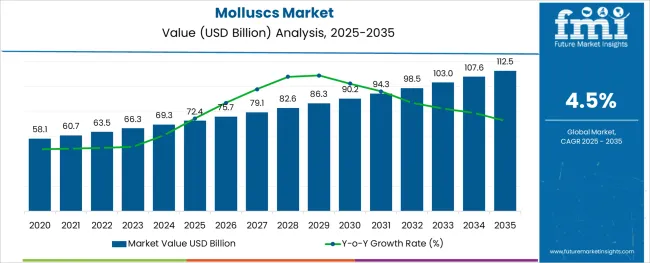
The molluscs market is experiencing strong growth, supported by rising consumer demand for seafood and increasing health awareness related to protein-rich diets. Industry publications have highlighted growing interest in sustainable aquaculture and improved harvesting techniques that enhance the availability and quality of molluscs.
Frozen mollusc products have gained popularity due to their extended shelf life and convenience, making them accessible to a broader customer base. The expansion of modern retail formats has also played a significant role in market growth by providing easier access to mollusc products in urban and suburban areas.
Additionally, government initiatives aimed at promoting seafood consumption and sustainable fisheries have supported the sector’s development. Future market expansion is expected to be driven by innovations in processing and packaging, as well as increased global trade. Segmental growth is expected to be led by Crassostrea species, frozen product forms, and hypermarkets and supermarkets as the dominant distribution channels.
The market is segmented by Species, Form, and Distribution Channel and region. By Species, the market is divided into Crassostrea, Ruditapes Philippinarum, Scallops, and Others. In terms of Form, the market is classified into Frozen and Canned. Based on Distribution Channel, the market is segmented into Hypermarkets and Supermarkets, Convenience Store, Online, and Others. Regionally, the market is classified into North America, Latin America, Western Europe, Eastern Europe, Balkan & Baltic Countries, Russia & Belarus, Central Asia, East Asia, South Asia & Pacific, and the Middle East & Africa.
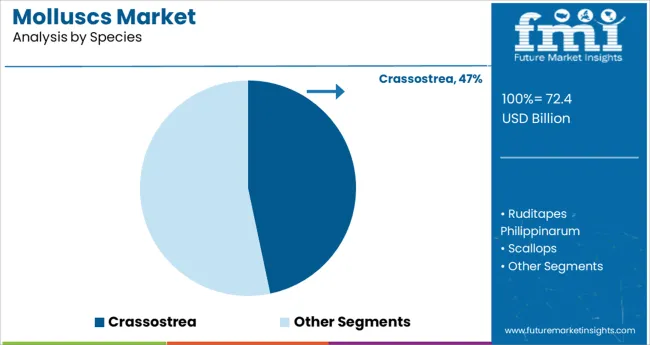
The Crassostrea segment is projected to contribute 46.7% of the molluscs market revenue in 2025, maintaining its leading position among species. This species is favored for its adaptability to various aquaculture environments and its recognized culinary value. Consumer preference for oysters and related products has supported consistent demand.
The segment benefits from ongoing improvements in farming practices that enhance yield and quality. Additionally, Crassostrea molluscs are widely available in multiple global markets, ensuring steady supply.
As sustainability standards evolve, producers have increasingly adopted eco-friendly cultivation techniques that appeal to environmentally conscious consumers. These factors have sustained the Crassostrea segment’s prominence in the market.
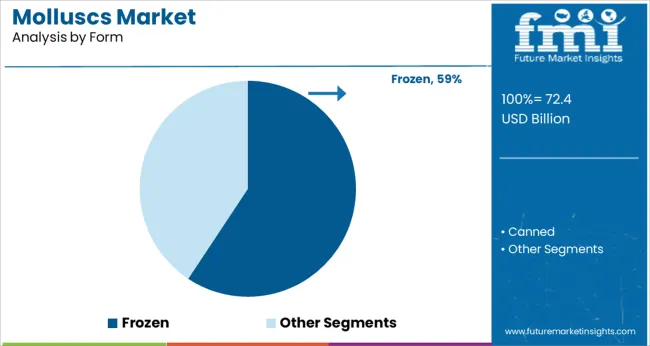
The Frozen segment is expected to hold 59.3% of the molluscs market revenue in 2025, asserting its dominance as the preferred product form. Frozen molluscs provide advantages in terms of extended freshness and reduced spoilage, which has led to their increased acceptance by both retailers and consumers.
The convenience of frozen products aligns with busy lifestyles, enabling easier storage and longer usage periods. Advances in freezing technology have helped preserve taste and nutritional value, further boosting consumer confidence.
Additionally, frozen mollusc products facilitate global distribution by overcoming geographical and seasonal constraints. The segment’s growth is also supported by expanding retail cold chain infrastructure in emerging and developed markets.
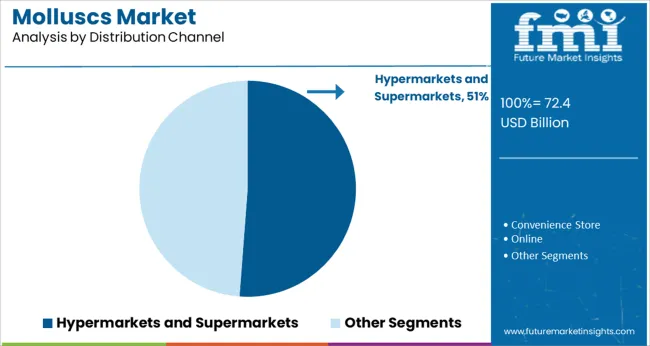
The Hypermarkets and Supermarkets segment is projected to represent 51.2% of the molluscs market revenue in 2025, remaining the dominant distribution channel. This segment’s growth has been driven by the increasing penetration of modern retail formats offering wide product assortments and consistent quality control.
These stores provide consumers with convenient access to a variety of mollusc products including fresh, frozen, and processed options. Retailers have invested in cold storage and display technology to maintain product freshness and appeal.
Promotional activities and strategic shelf placement have enhanced consumer visibility and purchase frequency. As consumer preferences shift toward organized retail for seafood purchases, hypermarkets and supermarkets continue to play a central role in mollusc product distribution.
The need for and consumption of protein-rich diets, rather than consuming high-calorie food products, is fueling the expansion of the global mollusk market. In addition to being a low-fat and abundant source of protein that is utilized to develop muscles, seafood also includes nutrients like vitamins, iron, and omega-3 fatty acids that are expected to surge the demand for molluscs.
Additionally, during the projected period, rising demand for processed seafood is also fueling molluscs market size.
The two main drivers of market expansion over the past few years have been rising consumer disposable income and a rising propensity toward a healthy lifestyle, which has resulted in an increase in the consumption of protein-rich foods.
During the projected period, the mollusks market size is likely to develop at a faster rate due to the rising demand for high-quality food products due to their increased freshness, variety, and ease of use for food safety.
Due to the rising need for protein sources, the cost of molluscan meat has also gone up over time. Strict government regulations, incentives, and rules are anticipated to impede the molluscs market in the near future.
Additionally, consumers' purchasing power has decreased along with their disposable income, which has a detrimental effect on market profits. The high cost of mollusk production is one of the major issues facing the molluscs market.
As a result, mollusk output has dropped during the previous few years. Due to the tremendous expansion in the human population, demand for mollusks is rising, even if molluscan production is declining.
The Crassostrea category holds over 30% of the molluscs market share in 2024.
The expansion of the molluscs market is being driven by the rising production of Crassostrea goods in emerging nations like China, India, and Japan. The molluscs market is expected to develop over the forecast period as a result of the rising consumer awareness of the importance of health.
During the forecast period, the scallops market is anticipated to grow at the quickest CAGR of 5.1%. Scallops are significant sources of human consumption protein, and this has led to an increase in demand, which has predicted the molluscs market expansion during the projection period.
The molluscs market is primarily driven by rising seafood consumption per capita around the world and an ageing population.
More than 55% of the revenue generated by the global molluscs market in 2024 came from the frozen category, which is projected to grow with a CAGR of 4.2% during the forecast period.
The need for healthful, nutrient-rich, and protein-rich foods among consumers has greatly increased the demand for frozen fish products. Additionally, the global molluscs market size is expected to develop during the forecast period due to the rising demand for processed and packaged fish products globally.
In 2024, the global molluscs market accounted for a share of more than 40% from the supermarket and hypermarket channels. Mollusc product suppliers employ the conventional retail channel to market, advertise, and sell their items through word-of-mouth.
Customers like to shop at hypermarkets and supermarkets, where they can personally inspect the products before making a purchase. Due to improved distribution channel networks around the world, supermarkets and hypermarkets are anticipated to maintain their dominance in the molluscs market during the projection period.
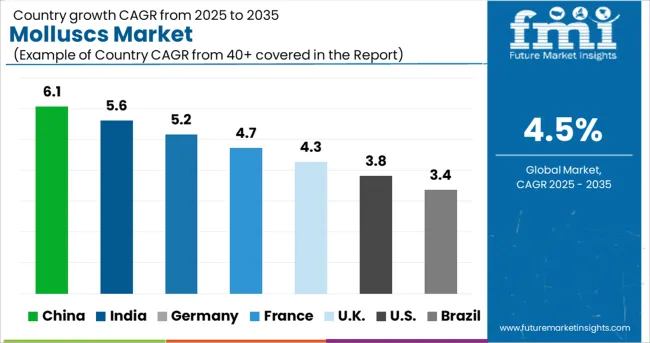
In 2024, Asia Pacific contributed the greatest share of more than 60% of the total market for molluscs.
This can be attributed to consumers' greater propensity for leading healthy lifestyles and rising disposable income, which in turn fuel demand for foods that are wholesome and nourishing. Due to the expanding need for fish food products that are high in protein, nations like China, India, and Japan are consuming more fish food products, which is fueling the molluscs market growth.
This has further demonstrated an increase in the manufacturing of mollusk goods, particularly in China and India, which have sizable consumer bases for food products.
The mollusk market in Europe is projected to develop at the quickest rate, with a CAGR of 5.1% during the forecast period.
During the projected period, the market is likely to develop at a faster rate due to the rising demand for high-quality food products due to their increased freshness, variety, and ease of use for food safety.
In nations like Germany, Spain, and Italy, mollusk products are becoming popular due to the growing public knowledge of their health advantages, which is fueling mollusc's market expansion.
The molluscs market is expected to grow in size during the forecast period as a result of increased investments by new molluscs market players' entry, Research and Development, product innovation, efficient resource allocation, technological advancements, and increased rivalry to grow customer and regional bases.
The San Diego-based business, which uses cell cultures to generate seafood, expanded on its commercialization plan and also published the layouts of its envisioned large-scale food production facilities, impacting the molluscs market.
Phase 1 of BlueNalu's five-phase roadmap, which focuses on Research and Development for its cell-based seafood, is still ongoing. In two to three years, they aim to begin selling their goods, and in five years, they hope to start construction on their first facility.
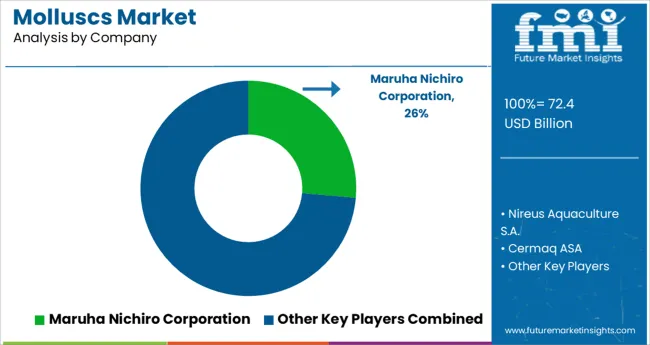
Due to the presence of numerous well-established market competitors and molluscs suppliers all over the world, the industry is fragmented. Businesses all across the world are focusing on process innovation and capacity development.
The global molluscs market is estimated to be valued at USD 72.4 billion in 2025.
It is projected to reach USD 112.5 billion by 2035.
The market is expected to grow at a 4.5% CAGR between 2025 and 2035.
The key product types are crassostrea, ruditapes philippinarum, scallops and others.
frozen segment is expected to dominate with a 59.3% industry share in 2025.






Full Research Suite comprises of:
Market outlook & trends analysis
Interviews & case studies
Strategic recommendations
Vendor profiles & capabilities analysis
5-year forecasts
8 regions and 60+ country-level data splits
Market segment data splits
12 months of continuous data updates
DELIVERED AS:
PDF EXCEL ONLINE

Thank you!
You will receive an email from our Business Development Manager. Please be sure to check your SPAM/JUNK folder too.
Chat With
MaRIA